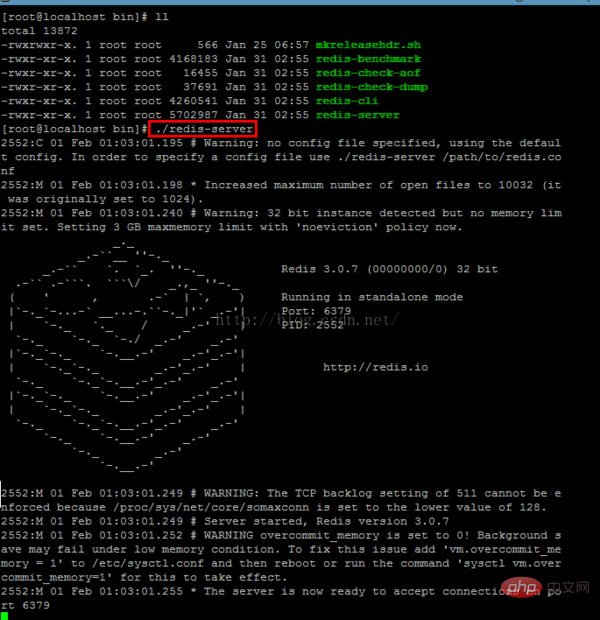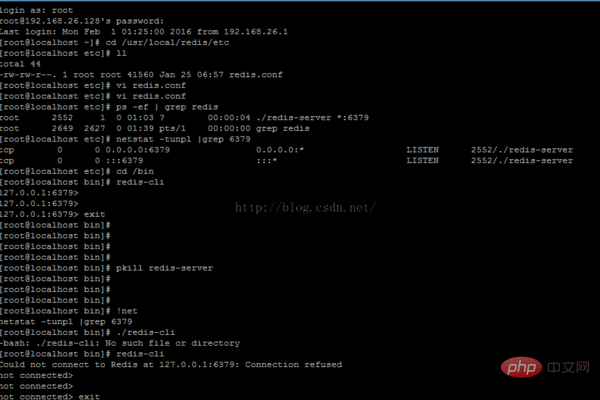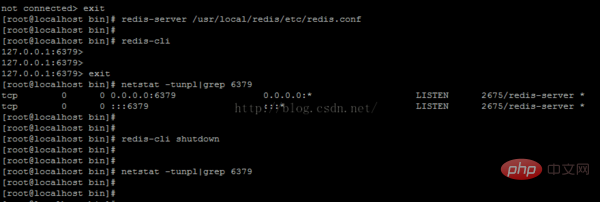
1. First, in order to facilitate management, move the conf configuration file and common commands in the Redis file into a unified file.
(1) Create bin and redis.conf files, copy the code "mkdir -p/usr/local/redis/bin; mkdir -p/usr/local/redis/ect";
(2) Execute the Linux file move command and copy the code "mv /lamp/redis-3.0.7/redis.conf /usr/local/redis/etc; cd /lamp/redis-3.0.7/src; mv mkreleasdhdr. sh redis-benchmark redis-check-aof redis-check-dump redis-cli redis-server /usr/local/redis/bin”;
2. Execute the Redis-server command to start the Redis service.

Note: The Redis service started by Redis-server is executed directly in the foreground (the effect is as shown above), that is to say, after executing the command, If Lunix closes the current session, the Redis service will also be closed. Under normal circumstances, starting the Redis service requires starting it from the background and specifying the startup configuration file.
3. Start the redis service in the background.
(1) First edit the conf file, change the daemonize attribute to yes (indicating that it needs to run in the background), the code is cd etc/; Vi redis.conf;
(2) Start again redis service, and specify the startup service configuration file, the code is redis-server /usr/local/redis/etc/redis.conf;

4. After the server is started successfully , execute redis-cli to start the Redis client and check the port number.

1. Introduction to Redis
Redis is one of the more popular NOSQL systems currently. It is a key-value storage system. It is similar to Memcache, but it largely compensates for the shortcomings of Memcache. It supports storing relatively more value types, including string, list, set, zset and hash. These data types support push/pop, add/remove, intersection, union, difference, and richer operations. On this basis, Redis supports various different ways of sorting.
Like Memcache, Redis data is cached in computer memory. The difference is that Memcache can only cache data into memory and cannot automatically and regularly write to the hard disk. This means that once the power is cut off or restarted , the memory is cleared and data is lost. Therefore, the application scenario of Memcache is suitable for caching data that does not need to be persisted. The difference with Redis is that it will periodically write updated data to disk or write modification operations to additional record files to achieve data persistence.
2. Summary of common commands for Linux and Redis operations
1. Linux: cd /usr is to enter the upper-level folder usr from a subfolder; cd local is from parent to child; mv /A /B is to move file A to B; vi usr/local/redis/redis.conf is to edit the redis.conf file;
2. Redis: Redis-server /usr..../redis.conf is to start the redis service and specify the configuration file; Redis-cli is to start the redis client; Pkill redis-server is to close the redis service; Redis-cli shutdown is to close the redis client: Netstat -tunpl|grep 6379 is to view the redis default port number 6379 occupancy status.
For more Redis-related technical articles, please visit the Redis Tutorial column to learn!
The above is the detailed content of How to start redis in linux. For more information, please follow other related articles on the PHP Chinese website!